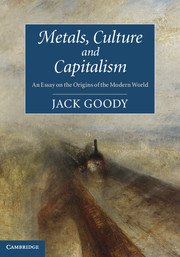Book contents
- Frontmatter
- Contents
- Maps
- Plates
- Preface
- Acknowledgements
- Chronology
- Part I Explorers
- 1 The Age of Metals in the Ancient Near East
- 2 A Bronze Age without bronze
- 3 Metals and society
- 4 Trade and religion in the Mediterranean
- 5 The coming of the Iron Age and classical civilisation
- 6 After the Romans
- Part II Merchants
- Part III Accumulators
- Appendix 1 The metallurgy of iron
- Appendix 2 Damascene steel and blades
- Glossary (with the aid of J. A. Charles)
- Bibliography
- Index
- Plate section
5 - The coming of the Iron Age and classical civilisation
Published online by Cambridge University Press: 05 June 2014
- Frontmatter
- Contents
- Maps
- Plates
- Preface
- Acknowledgements
- Chronology
- Part I Explorers
- 1 The Age of Metals in the Ancient Near East
- 2 A Bronze Age without bronze
- 3 Metals and society
- 4 Trade and religion in the Mediterranean
- 5 The coming of the Iron Age and classical civilisation
- 6 After the Romans
- Part II Merchants
- Part III Accumulators
- Appendix 1 The metallurgy of iron
- Appendix 2 Damascene steel and blades
- Glossary (with the aid of J. A. Charles)
- Bibliography
- Index
- Plate section
Summary
At a certain point in Antiquity the eastern Mediterranean suffered a series of disturbances that accompanied the diminishing use of bronze, perhaps because of difficulties in importing tin. That resulted in the greater prominence of iron as an alternative, for this was locally available. It is generally thought that iron was known as a workable metal during most of the Bronze Age. In its natural state it was widely available on the earth’s surface, of which its ores make up 5 per cent of the total, and as its acquisition seldom involved deep mining it could be easily recovered. Nevertheless it required labour-intensive methods to process and to begin with it was therefore costly. Iron is somewhat different from the other metals. Although it is widespread, in the west the ‘bloom’ could only be worked by smithying to give wrought iron, while in China, which had wrought iron about 800–600 bce, the history was different and higher heats were possible so iron ore could eventually be made liquid and cast, leaving its slag free. Pure iron has a melting point of 1540 degrees Centigrade (higher than copper at 1083 degrees) and in Europe this temperature could only be obtained in the Middle Ages or even on a large scale in the eighteenth or nineteenth centuries. So early iron in the west had to be produced by partial reduction at about 1200 degrees with the aid of charcoal. At this heat iron ore yields not a puddle but a spongy mass (a ‘bloom’) mixed with slag. This is what the blacksmith has to work with, making iron articles by heating and hammering the product to get rid of the unwanted impurities. The result was a ‘poor substitute’ for bronze, especially as it was brittle in its normal state. What changed the situation and led to a greatly increased use was the creation of a carburised form, in which bloom iron was treated to make it harder, not only by carburisation but by quenching and tempering. All of these processes seem to have been discovered on the spot by blacksmiths working with the actual metal. It was only in the carburised form of steel made with added charcoal that the metal had distinct advantages over copper. Carburisation lowered the melting point of pure iron but it needed the addition of lime to clear the slag.
- Type
- Chapter
- Information
- Metals, Culture and CapitalismAn Essay on the Origins of the Modern World, pp. 85 - 119Publisher: Cambridge University PressPrint publication year: 2012



